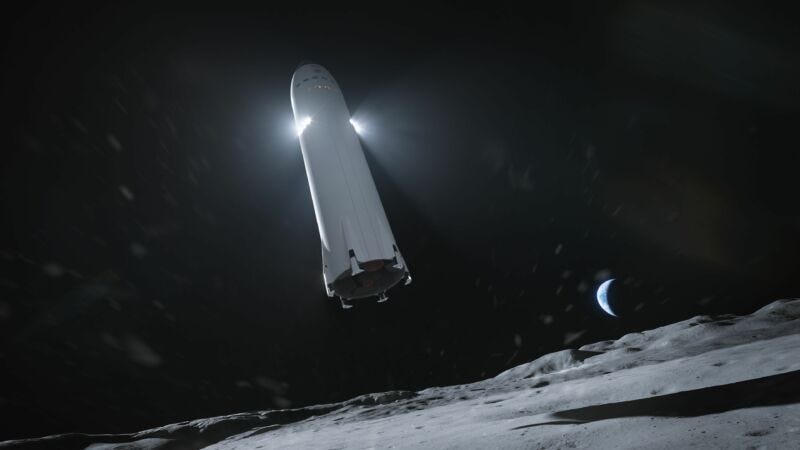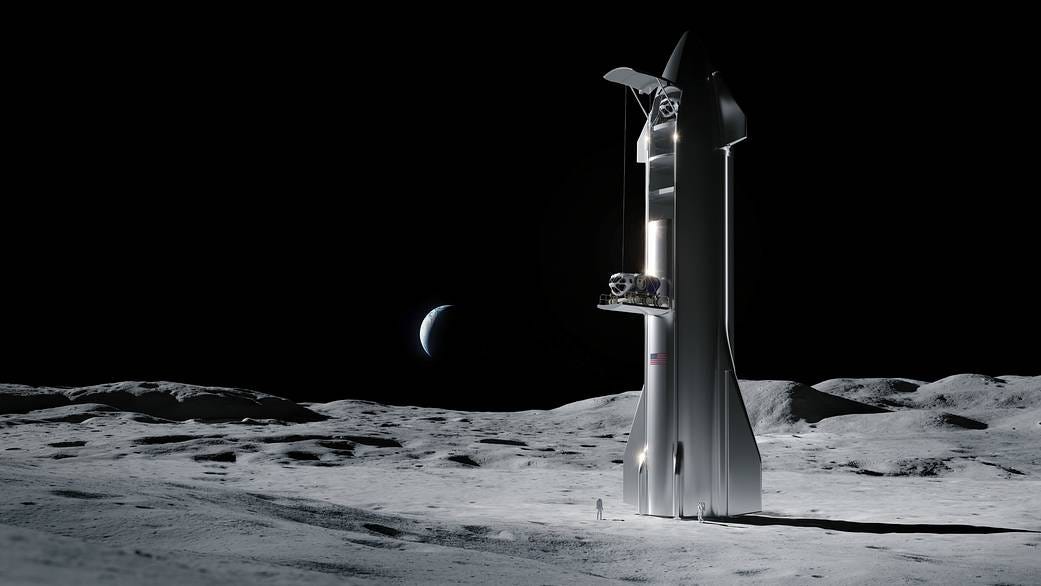HLS Practically Perfect
SpaceX Space Freighter
SpaceX’s contribution to the Artemis Program is called the Starship Human Landing System (HLS), which is essentially a variant of their Starship spacecraft, designed to land NASA astronauts on the moon. Some degree of controversy surrounds this vehicle’s suitability as a lunar lander, principally because its overall height and mass is an order of magnitude greater than technically required for this mission. Where the Apollo lander was only 4.28 tonnes, Starship HLS should weigh-in at ~100 tonnes and stand some 50m tall, if it is anything like the standard Starship spacecraft.
Past landers, like Apollo’s, were far more conservative because the entire vehicle’s mass had to be launched on a single rocket, as part of it upper stage payload. However, Starship uses three innovative methods to increase the landed mass: -
Entire upper stage used as a lander – Apollo crews used the Command and Service Module (CSM) and Lunar Excursion Module (LEM) at different stages of the flight, each of which carried duplicate life support, flight control and communication systems. Hence combining these functions into one command and descent vehicle should be a more efficient use of payload mass, made possible by advances in computer technology (ship systems can be controlled via touchscreens or tablets from anywhere on the vehicle).
“The [Starship] technology will likely be similar to Dragon, but the design, usage, and goals of the onboard Starship UI [User Interface] are notably different from Dragon. The Dragon Crew Displays are three touchscreens in a small vehicle with a singular destination, supporting a small group of passengers and their cargo. Starship will fly missions to locations worldwide, the Moon, Mars, and beyond. The Starship UI must be usable on devices and touchscreens of all sizes around the vehicle (common areas, living quarters, loading areas, and the bridge) and must support users with completely different jobs and skillsets.” ~ Asher Dunn/Lead Starship Software developer
180 thrust to weight ratio engines – high thrust to weight engines are a real boon to rocketry, because they help to reduce gravity drag. Whenever a vehicle is ascending, the engines have to support the entire weight of the vehicle while also attempting to accelerate it to orbital velocity. Hence higher thrust engines result in greater vehicle acceleration, which reduces the time spent fighting gravity, allowing more payload to be carried in place of fuel. Note, this is doubly true for Starship because it uses high thrust Raptor engines on both the Booster stage (used for Earth ascent) and the Starship spacecraft (used to escape Earth’s gravity).
In-space refueling – no doubt the biggest contributor to Starship’s usable mass is orbital refueling. Previously much of the vehicle mass sent to orbit had to be reserved for the propellant required to send it further. However the Starship launch vehicle can essentially run its main tanks empty, allowing the maximum amount of hardware to be placed in orbit. Then Starship docks with a friendly propellant depot to refill its tanks in orbit and go on its merry way, carrying a truly unprecedented payload (100+ tonnes).
HLS Operation
Originally Starship was designed as a Mars landing spacecraft, hence convention suggests it might be less than ideal as a lunar lander. However, the operational advances inherent to Starship allow it to far exceed the norm, where a vehicle’s mass and volume were so constrained it had to be exquisitely tailored to suit each mission.
To illustrate: SpaceX intend to launch a HLS demonstration vehicle to the moon in 2025, to prove it can land at the lunar south pole. This should require 5.66 km/s of delta-v for the vehicle to depart Low Earth Orbit (LEO) and descend safely to the lunar surface, which should be possible considering the vehicle has 6.9 km/s delta-v with a full fuel load. If SpaceX can preposition a propellant depot in LEO, it should only take 6 Tanker flights to provide the necessary propellant to fully refuel the HLS demonstrator, assuming each tanker carries 200 tonnes to orbit (possible with a stripped down Starship vehicle, fitted with Raptor 3 engines). So to achieve this mission, they need only produce one Super Heavy Booster and three Starship vehicles i.e: a Tanker, a Propellant Depot and a HLS demonstrator vehicle; assuming full reuse is possible, and the demonstrator is expendable.
All well and good, however, operational HLS flights need to rendezvous with an Orion capsule in Near Rectilinear Halo Orbit around the moon, then descend with two astronauts to the lunar surface before finally ascending back to the waiting Orion. Altogether this should take 8.85 km/s delta-v, which technically exceeds the delta-v budget for the HLS vehicle… However, if SpaceX deploy another propellant depot in NRHO, that should provide sufficient fuel for HLS to shuttle between Orion and the lunar surface, which requires only 4.9 km/s delta-v per round trip. Of course the NRHO Depot will need to be refilled after each trip, which could be accomplished using 2 Tanker flights from LEO, assuming propellant boil-off is kept reasonably low enroute to NRHO, and aerobraking can be used on the Tanker’s return leg to LEO. All told each HLS landing should require 12 Tanker launches to LEO and 2 Tanker flights to NRHO, to resupply the Propellant Depot kept there on permanent station.
Big Win
On the face of it HLS adds a lot of complexity compared to more conventional lunar landers, like the LEM. However times have changed, NASA now intend to build a base on the moon, which will require an order of magnitude more people and equipment than previously supplied on Apollo missions. HLS should be practically perfect in this role, because each vehicle could deliver up to 100 people or 200 tonnes of useful payload to the lunar surface. The vehicle has over 1,000 m3 of pressurized volume, which should allow NASA to use it as a foundation habitat for base building; to help visualize, it’s like landing a skyscraper on the moon! In addition, SpaceX have their own plans for moon operations. The first logical step is to establish propellant production at the lunar south pole, to reduce the number of Tanker launches from Earth and increase flight frequency/reliability. Almost anything is possible with a vehicle as capable as Starship, which is more reminiscent of spacecraft used in science fiction.
In Conclusion
While it might appear HLS is a square peg for a round hole, in reality it fills a mighty large hole in space launch capabilities. Once operational, it should allow NASA to build the moon base they have long desired, dating back to the days of the Apollo Program. In fact, the infrastructure network HLS helps to create should enable a true space economy to evolve, as many more people come to live and work in cislunar space and the moon.




I am a happy camper, having just found this substack. Excellent writing, well researched, visionary, grounded in reality, this is great. I am not easily impressed but love to give credit where it is due and that's what just happened. Imma gonna read the rest of your articles to get caught up, glad I found you when I did. Sorry I am too broke to pledge.
So if one thinks about the lunar true believers in the NASA ecosystem, Paul Spudis types, how thrilled must they be? All of a sudden they are promised a great big delivery of equipment right at the start of the program! What a boon if and when it comes to pass.